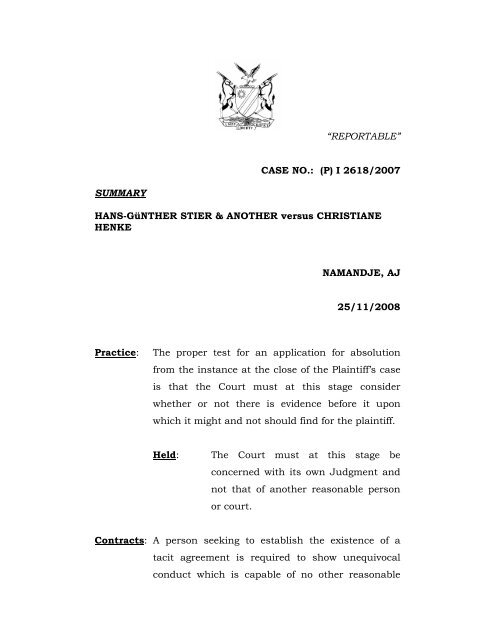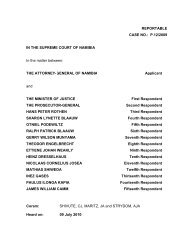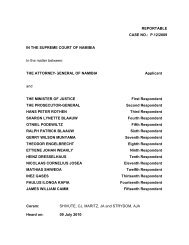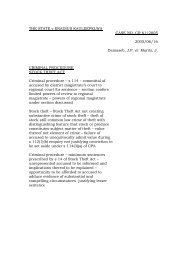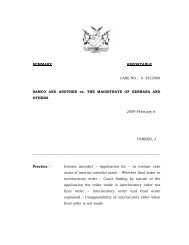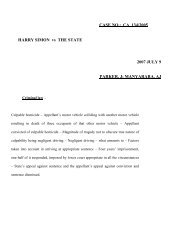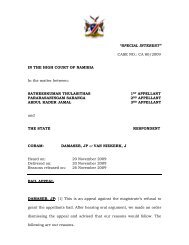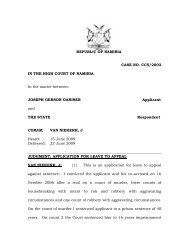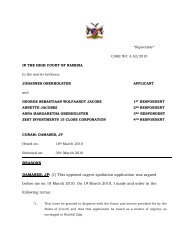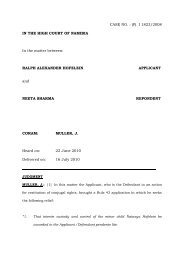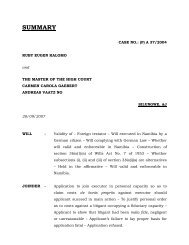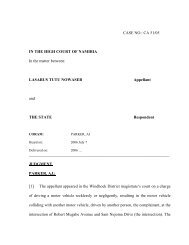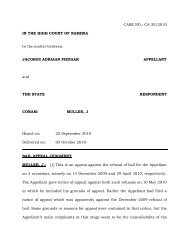HANS-GUNTHER STIER AND BERNHARD VENTE versus ...
HANS-GUNTHER STIER AND BERNHARD VENTE versus ...
HANS-GUNTHER STIER AND BERNHARD VENTE versus ...
Create successful ePaper yourself
Turn your PDF publications into a flip-book with our unique Google optimized e-Paper software.
SUMMARY<br />
“REPORTABLE”<br />
CASE NO.: (P) I 2618/2007<br />
<strong>HANS</strong>-GüNTHER <strong>STIER</strong> & ANOTHER <strong>versus</strong> CHRISTIANE<br />
HENKE<br />
NAM<strong>AND</strong>JE, AJ<br />
25/11/2008<br />
Practice: The proper test for an application for absolution<br />
from the instance at the close of the Plaintiff’s case<br />
is that the Court must at this stage consider<br />
whether or not there is evidence before it upon<br />
which it might and not should find for the plaintiff.<br />
Held: The Court must at this stage be<br />
concerned with its own Judgment and<br />
not that of another reasonable person<br />
or court.<br />
Contracts: A person seeking to establish the existence of a<br />
tacit agreement is required to show unequivocal<br />
conduct which is capable of no other reasonable
interpretation than that the parties intended to and<br />
did in fact agree on the terms alleged. It must<br />
further be clear on the facts that from the parties’<br />
conduct there was in fact consensus ad idem.<br />
Courts are cautioned to be continually on their<br />
guards against being persuaded to introduce terms<br />
in contract not necessarily intended and agreed<br />
upon by the parties and not to readily impose<br />
agreements on the parties in cases of alleged tacit<br />
agreements.<br />
While silence in some cases, depending on the<br />
facts, may amount to acceptance of an offer and<br />
result in an enforceable contract, tacit contracts are<br />
not easily inferred from silence.<br />
2
IN THE HIGH COURT OF NAMIBIA<br />
In the matter between:<br />
3<br />
CASE NO: (P) I 2618/2007<br />
<strong>HANS</strong>-GÜNTHER <strong>STIER</strong> 1 ST PLAINTIFF<br />
<strong>BERNHARD</strong> <strong>VENTE</strong> 2 ND PLAINTIFF<br />
and<br />
CHRISTIANE HENKE DEFENDANT<br />
CORAM: NAM<strong>AND</strong>JE, AJ<br />
Heard on: 28, 29 & 30/10/2008; 10 & 11/11/2008<br />
Delivered on: 25.11.2008<br />
JUDGMENT:<br />
NAM<strong>AND</strong>JE, AJ: [1] In this matter the trial progressed up to the stage<br />
where the plaintiffs’ case was closed and the defendant brought an<br />
application for absolution from the instance.
[2] The first plaintiff is Hans Günther Stier, a chartered accountant,<br />
who was since 2001 until 31 October 2005 practising in a partnership of<br />
chartered accountants, with the second plaintiff and defendant under the<br />
name and style Stier Henke Associates. Stier presently practises in<br />
partnership with the second plaintiff under the name and style Stier<br />
Vente Associates. From 1996 Stier initially only practised with the<br />
defendant until joined by one Schuckmann in 1998 and later by Vente in<br />
2001.<br />
[3] The second plaintiff is Bernard Vente, also a chartered accountant,<br />
who practised in partnership with the first plaintiff and defendant as<br />
aforesaid from January 2001 until 31 October 2005 and currently<br />
practises as a chartered accountant in partnership with the first plaintiff<br />
under the name and style, Stier Vente Associates.<br />
[4] The defendant is Christiane Henke, a chartered accountant. She<br />
was in partnership with the plaintiffs until 31 October 2005. The<br />
defendant gave her notice of resignation from the partnership during<br />
April 2005 and resigned on 31 October 2005.<br />
[5] For the sake of convenience the two plaintiffs, shall be referred to<br />
jointly as the plaintiffs, the first plaintiff shall be referred to as “Stier”<br />
and second plaintiff shall be referred to as “Vente.”<br />
4
[6] The plaintiffs brought an action against the defendant in which they<br />
claim an amount of N$1, 074, 688.00 as a result of the alleged breach of<br />
the terms of a tacit agreement (terms of which are recorded in an<br />
unsigned document hereinafter for convenience sake, to be referred to as<br />
the unsigned document and which is referred to in the particulars of<br />
claim as annexure “B” or new agreement) on the ground set out under<br />
the relevant paragraphs of the particulars of claim as set out herein<br />
below.<br />
[7] Some of the relevant parts of the plaintiffs’ particulars of claims (as<br />
amended) read as follows:-<br />
entered<br />
“4. On 20 December 1996 the first plaintiff and the defendant<br />
into a written partnership agreement annexed hereto marked<br />
annexure “A”. (the old partnership agreement) on the basis<br />
whereof they practised in partnership as chartered accounts<br />
and auditors from September 1996 to 31 December 2000 (the<br />
old partnership).<br />
5. It was an explicit term of the old partnership agreement that:-<br />
“19. If a partner shall cease for any reason whatsoever to be<br />
a partner save as is specifically authorized in advance<br />
by the Senior Partner, he shall not, directly or indirectly,<br />
whether as principal or agent, for a period of 2 years<br />
from the date upon which he ceases to be a partner ask<br />
5
for, or accept business from clients who are clients of<br />
the firm at the date of his ceasing to be a partner or who<br />
were clients within a period of twelve months prior to<br />
the date upon which he ceases to be partner.<br />
20. Should any partner who leaves the firm contradict 19<br />
above, the remaining partners of the firm shall be<br />
entitled, as an alternative to seeking and interdict<br />
against the retiring partner, to claim from the retiring<br />
partner, who shall be obliged to pay on demand, an<br />
amount equal to the gross fees charged to that client or<br />
those clients for a twelve month period based on the<br />
latest billings of the firm to that client in respect of<br />
services rendered for an entire year.”<br />
6. Subsequent to 15 January 2004, the first and the<br />
second plaintiff and the defendant, (the parties) tacitly<br />
entered into a new partnership agreement with the<br />
terms as set out in annexure “B” hereto (the new<br />
partnership agreement). The new partnership<br />
agreement was not signed, but the parties implemented<br />
Annexure “B” by acting upon it with full knowledge of its<br />
contents.<br />
7.1 Clauses 19 and 20 of the old partnership agreement<br />
were effectively incorporated in clause 8 of Annexure B.”<br />
[8] The plaintiffs claim that the defendant, after her resignation,<br />
accepted business from former clients of the partnership in breach of the<br />
6
above clauses 19 and 20, which were initially terms of the old agreement<br />
and subsequently incorporated in the unsigned document which,<br />
according to the plaintiffs, was tacitly entered into as a contract by the<br />
parties. The defendant in her plea admitted, with some qualifications,<br />
that she accepted business from former clients of the partnership within<br />
the period of two years after her resignation but denies that the parties<br />
tacitly entered into an agreement which includes clauses 19 and 20 as<br />
pleaded by the plaintiffs and as reflected in the unsigned document<br />
dated 15 January 2004.<br />
[9] The written partnership agreement between Stier and the defendant<br />
that subsisted from 1996 to 1998 and which is referred to in the<br />
particulars of claim as the old agreement shall be referred to herein as<br />
such. The plaintiffs’ claim is based on the allegations that clauses 19<br />
and 20 as reflected under paragraph 5 of the above quoted part of the<br />
plaintiffs’ particulars of claim, which also appear in paragraph 8 of the<br />
unsigned document dated 15 January 2004, were breached by the<br />
defendant. It is therefore the plaintiffs’ case that the defendant is liable<br />
to compensate them in the amount of N$1,074,688.00 in terms of<br />
paragraph 20 as quoted hereinabove. The crucial question at this stage<br />
is whether or not on the evidence proffered by the plaintiffs at the close<br />
of their case, it might be found for the plaintiffs that the unsigned<br />
document reflects the agreement tacitly entered into by the three parties.<br />
7
[10] The defendant, while admitting in her plea that the parties practised<br />
in partnership as chartered accountants and auditors from 1 January<br />
2001 to 31 October 2005 and that she had knowledge of the content of<br />
the unsigned document (being the unsigned copy of the document<br />
embodying the terms alleged by the plaintiffs to have been tacitly agreed<br />
upon by the parties, subsequent to 15 January 2004), she denies that<br />
the parties tacitly entered into the alleged agreement. She, in alternative,<br />
raised a number of defences in the event of this court finding that the<br />
parties tacitly entered into the agreement alleged by the plaintiffs. The<br />
alternative grounds are not relevant for purposes of the present<br />
judgment.<br />
[11] After the close of the plaintiffs’ case counsel for the defendant<br />
applied for absolution from the instance with costs. He sought such an<br />
order solely on the ground that at the close of the plaintiffs’ case no<br />
prima facie case was made out that the parties tacitly entered into the<br />
alleged agreement incorporating the terms on which the plaintiffs’ claim<br />
is based. After hearing arguments from Mr R Strydom, counsel for the<br />
defendant and Mr R Heathcote, counsel for the plaintiffs this court<br />
reserved judgment.<br />
[12] Over the years, courts have expressed and formulated the test to be<br />
applied when absolution from the instance is sought at the close of the<br />
8
plaintiff’s case in slightly varying terms but without changing the<br />
essential content, principle and elements of the test. I am of the view,<br />
from reading various authorities, that whatever the expression of the test<br />
has been – the proper test is that any court considering an application<br />
for absolution from the instance at this stage must consider whether or<br />
not there is evidence before it upon which it might and not should, find<br />
for the plaintiff. If there is such evidence absolution from the instance<br />
cannot be granted. It goes without saying that at any stage of the trial,<br />
inclusive of the application for absolution, the court is invariably<br />
required to act and apply its mind carefully and reasonably. I intend<br />
doing that too. The test is as clearly set out in Gordon Lloyd Page and<br />
Associates v Rivera and Another 2001 (1) SA 88 where Harms JA at pages<br />
92 E to I to 93 A to B, stated the following:-<br />
“{2} The test for absolution to be applied by a trial court at the end<br />
of a plaintiff’s case was formulated in Claude Neon Lights (SA)<br />
Ltd v Daniel 1976 (4) SA 403 at 409G – H in these terms:<br />
‘…(W)hen absolution from the instance is sought at the close<br />
of plaintiff’s case, the test to be applied is not whether the<br />
evidence led by plaintiff establishes what would finally be<br />
required to be established, but whether there is evidence upon<br />
which a Court, applying its mind reasonably to such evidence,<br />
could or might (not should, nor ought to) find for the plaintiff.<br />
(Gascoyne v Paul and Hunter 1917 TPD 170 at 173; Ruto Flour<br />
Mills (Pty) Ltd v Adelson (2) 1958 (4) SA 307 (T).’<br />
9
This implies that a plaintiff has to make out a prima facie case<br />
– in the sense that there is evidence relating to all the<br />
elements of the claim – to survive absolution because without<br />
such evidence no court could find for the plaintiff (Marine &<br />
Trade Insurance Co. Ltd v Van der Schyff 1972 (1) SA 26 (A) at<br />
37G – 38 A; Schmidt Bewysreg 4 th ed at 91 – 2). As far as<br />
inferences from the evidence are concerned, the inference<br />
relied upon by the plaintiff must be a reasonable one, not the<br />
only reasonable one (Schmidt at 93). The test has from time to<br />
time been formulated in different terms, especially it has been<br />
said that the court must consider whether there is ‘evidence<br />
upon which a reasonable man might find for the plaintiff’<br />
(Gascoyne (loc cit))- a test which had its origin in jury trials<br />
when the ‘reasonable man’ was a reasonable member of the<br />
jury (Ruto Flour Mills). Such a formulation tends to cloud the<br />
issue. The court ought not to be concerned with what<br />
someone else might think; it should rather be concerned with<br />
its own judgment and not that of another “reasonable” person<br />
or court. Having said this, absolution at the end of a<br />
plaintiff’s case, in the ordinary course of events, will<br />
nevertheless be granted sparingly but when the occasion<br />
arises, a court should order it in the interests of justice.<br />
Although Wunsh J was conscious of the correct test, I am not<br />
convinced that he always applied it correctly although, as will<br />
appear, his final conclusion was correct.” (Own emphasis)<br />
I agree with Harms JA in toto and in particular, that the court must at<br />
this stage be concerned with its own judgment and not that of another<br />
reasonable person or court. I adopt that approach as the conclusion<br />
would in any event be the same. I also agree that the inference to be<br />
10
drawn from the plaintiffs’ evidence should not necessarily be the only<br />
reasonable inference, but a reasonable one. The test as referred to in<br />
Tutaleni Reinhold Shiimi v Mutual & Federal Insurance Company of<br />
Namibia, unreported Case No. (P) I 2269/07 Judgment delivered on<br />
28.11.2007 at page 5, should therefore be applied mutatis mutandis, in<br />
conjunction with the above.<br />
[13] Any court seized with an application for absolution from the<br />
instance at the close of the plaintiff’s case should consider evidence in<br />
relation to the pleadings and the requirements of the law applicable to<br />
the particular case (See Bidoli v Ellistron t/a Ellistron Truck & Plant 2002<br />
NR 451 at page 453 E to F).<br />
[14] Stier who was the first witness, and in my opinion the main witness<br />
for the plaintiffs, testified that he worked at PriceWaterhouseCoopers<br />
from 1978 to 1995 as a chartered accountant. The defendant also<br />
worked at PriceWaterhouseCoopers where she, at some point, served as<br />
an articled clerk under him. He decided to leave<br />
PriceWaterhouseCoopers and ultimately left with the defendant and the<br />
two formed a partnership of chartered accountants under the name and<br />
style Stier Henke Associates in 1996.<br />
11
[15] Stier and the defendant entered into a written partnership<br />
agreement which was signed by both parties on 20 December 1996<br />
hereinafter referred to as the old agreement. In terms of the old<br />
agreement the profit and loss of the partnership were shared at a ratio of<br />
70% for Stier and 30% for the defendant. The old agreement explicitly<br />
made provision for other matters such as, annual leave, salaries,<br />
admission of additional parties, termination of partnership, entitlements<br />
and benefits at termination and retirements. Most importantly, the old<br />
agreement made provision for a restraint in trade against a party ceasing<br />
to be a partner as reflected under clause 19 as pleaded under paragraph<br />
5 of the relevant part of the particulars of claim quoted herein supra.<br />
[16] Although Stier initially testified that the old agreement between him<br />
and the defendant was turned into an oral agreement with the same<br />
terms, save for few changes when Vente joined the partnership in 2001,<br />
he later readily conceded during cross-examination that he cannot<br />
remember all the terms of the oral agreement after Vente joined as a<br />
third partner. During cross-examination it became clear that between<br />
January 1998 and June 1999 before Vente joined as a partner, one<br />
Schuckmann was admitted as a partner effectively resulting in the<br />
termination of the old agreement between Stier and the defendant. This<br />
aspect was not addressed by Stier during his evidence in chief. He was<br />
unable to remember the terms of the agreement between the partners<br />
12
when Schuckmann joined as a partner from January 1998 to June 1999<br />
when the latter left the partnership. He however conceded that the<br />
partnership agreement at that point (after 1998) was oral. On the<br />
evidence of the plaintiffs, as a whole, it is clear that the old agreement<br />
terminated in 1998 when Schuckmann became a partner. This is<br />
contrary to the plaintiffs’ 4 th paragraph of the particulars of claim in<br />
terms of which it is pleaded that Stier and the defendant practised as a<br />
partnership in terms of the old agreement from September 1996 to 31<br />
December 2000.<br />
[17] Stier testified further that he and the defendant offered Vente<br />
partnership in 2001, equivalent to ten percentages of the partnership<br />
and Vente’s stake was later increased by seven percentages in September<br />
2003. This left the partnership’s profit/loss sharing ratio broken up as<br />
follows, Stier 55%, defendant 28% and Vente 17%. Except for the profit<br />
and loss sharing ratio after Vente became a partner in 2001 no other<br />
terms on the plaintiffs’ evidence were explicitly agreed upon or could<br />
reasonably be inferred from his evidence. He did not testify of the parties<br />
having, at any point after the old agreement terminated in 1998,<br />
discussed and agreed upon restraint of clauses or any other terms of the<br />
partnership agreement, i.e., terminations, leave days, retirements,<br />
resignations, etc.<br />
13
[18] Stier testified that without prior negotiation or discussion with the<br />
defendant or Vente he, prior to 15 January 2004, drafted an agreement<br />
which was essentially the same, in terms, as the old agreement with<br />
minor changes. After drafting it he gave it to the defendant to type as it<br />
was a confidential document and did not want other persons in the office<br />
to become aware of it. He does not remember how and when exactly he<br />
got back the typed draft agreement (the unsigned document) from the<br />
defendant. The unsigned document reflects “15 January 2004” at the<br />
space usually meant for date of signatures. It is however not signed at<br />
the spaces provided for signatures of the three parties.<br />
[19] He testified that no negotiation or discussion relating to the content<br />
and terms of the unsigned document took place after it was typed by the<br />
defendant. He did not receive comments from either the defendant or<br />
Vente on the terms of the unsigned document. He testified that partners<br />
met on Thursdays of each week to discuss planning and other matters<br />
pertaining to their partnership. He testified further that the issue of<br />
finalisation and signing of the unsigned document was occasionally<br />
raised after 15 January 2004, however the parties did not sign and<br />
finalise the unsigned document until the resignation of the defendant.<br />
He could not offer any reasonable explanation as to why that was not<br />
done if regard is had to the fact that the parties met every Thursday and<br />
probably saw each other every day at the office.<br />
14
[20] Stier was taken through the old agreement by counsel for the<br />
defendant and admitted that he extracted the terms of the unsigned<br />
document therefrom however he introduced various major amendments.<br />
During his testimony under cross-examination he was surprised when<br />
he was alerted of the inclusion, and in some cases absence, of some<br />
terms in the unsigned document when looked at against the old<br />
agreement. At one point during Stier’s testimony under cross-<br />
examination his evidence was as follows:-<br />
“The Counsel’s question is: What could have been the reason<br />
for paragraph 6 of the old agreement not to be in the new<br />
agreement? - Lord, I cannot answer that one at the moment. I<br />
don’t know what my reasoning was then for taking it out. If<br />
I’ve taken it out. At the moment I am not yet saying that I<br />
took it out. Because it’s very strange to me why I should have<br />
taken it out.”<br />
[21] When Stier was asked by counsel for the defendant as to why the<br />
clause on overtime which appeared in the old agreement text does not<br />
appear in the unsigned document, he simply stated that:-<br />
“My comment on that is, as I stand here at the moment, I<br />
cannot imagine any reason why I should have taken that out<br />
in my draft. So I am putting a question mark behind it.”<br />
15
Then counsel for the defendant continued:-<br />
“Do you suggest that the agreement was maybe not correctly<br />
typed?”<br />
Stier replied: “It should have been there, yes.”<br />
[22] The above shows directly and inferentially that even Stier himself<br />
could not have, with the requisite animus contrahendi, tacitly entered<br />
into the agreement alleged as reflected in the unsigned document. All<br />
indications are, in my opinion, to the contrary. A question could be<br />
asked – how can the first plaintiff (Stier) rely on the alleged tacit<br />
agreement – as reflected in the unsigned document when, he himself,<br />
was during this trial surprised by the absence or presence of some terms<br />
in the unsigned document? He also could not clearly explain why he<br />
materially changed some clauses of the old agreement when<br />
incorporating such in the unsigned document.<br />
[23] Stier did not on the face value, tender sufficient evidence that shows<br />
that the parties tacitly entered into the agreement alleged, nor did he<br />
point to any conduct on the basis of which it can be reasonably inferred<br />
that the parties mutually intended to enter, and indeed did, into an<br />
agreement as reflected in the unsigned document. Stier’s assertion that<br />
16
the parties entered into the alleged tacit agreement was solely based on<br />
the fact that after he provided the defendant with a draft copy of the<br />
unsigned document to type, without prior negotiation thereof, he did not<br />
receive any complaint from the defendant regarding the terms thereof<br />
between January 2004 and April 2005 when the defendant notified Stier<br />
and Vente of her intended resignation. This is, according to Stier,<br />
sufficient proof that the parties have tacitly entered into an agreement as<br />
reflected in the unsigned document on which the plaintiffs’ case is based.<br />
Taking into account his evidence and that of the other two plaintiffs’<br />
witnesses at this stage, on the face value, I am unpersuaded that, that is<br />
the case.<br />
[24] The second plaintiffs’ witness was Jens Christian Kuehhirt. He was<br />
called as an expert. He was called to testify inter alia on certain customs<br />
within the chartered accountants’ profession in particular, that parties<br />
make use of clauses in restraint of trade in their partnership agreements<br />
to make provision for a resigning partner, for a certain period of time, not<br />
to accept business from clients previously served by the partnership. His<br />
evidence was, by large measure, only relevant if this court were to find<br />
that the parties as alleged tacitly contracted on the terms as per the<br />
unsigned document. I have however fully considered all aspects of his<br />
evidence that may have been relevant at this stage.<br />
17
[25] The third and last plaintiffs’ witness was Vente. While Stier testified<br />
that the terms of the old agreement between him and the defendant were<br />
incorporated in the oral contract between the three parties when Vente<br />
became a partner in January 2001, Vente testified that he was not aware<br />
of the terms of the old agreement and further did not see it until at the<br />
time of preparation for the trial in this matter. He did not specifically<br />
tender any evidence to the effect that the parties ever discussed and<br />
agreed on the terms of a restraint of trade and other incidental clauses<br />
on which the plaintiffs’ case is based.<br />
[26] Vente does not remember as to when he got a copy of the unsigned<br />
document and from whom he got it. He testified that when he saw the<br />
unsigned document he was happy with it as it incorporated what was<br />
discussed two or three years before that. His evidence that the unsigned<br />
document incorporated terms discussed two to three years before soon<br />
became porous during cross-examination as it became clear on his own<br />
testimony that there has not been discussion of the terms of the<br />
unsigned document. Stier, in this respect, testified that until he drafted<br />
the draft agreement around January 2004 there were no prior<br />
discussions or negotiations between the parties. When asked by the<br />
defendant’s counsel why the unsigned document was not signed, Vente<br />
inter alia stated that it always happened that none of the parties at a<br />
particular time would have a copy available for signatures. He conceded<br />
18
that none of his partners made an offer to him to accept or reject the<br />
terms of the unsigned document. He testified that the unsigned<br />
document was yet to be formalized and signed until the resignation of the<br />
defendant. He further testified that around January 2005 the defendant<br />
indicated that she was not happy with the terms of the unsigned<br />
document. He did not however alert Stier of the defendant’s<br />
unhappiness until after the resignation of the defendant. He did not take<br />
the unsigned document to Stier for discussion when he was given a copy<br />
thereof. It is important to observe that Vente at one point, before he<br />
changed his version, conceded during cross-examination that the oral<br />
agreement between the parties that came into force when he became a<br />
partner in 2001 was to continue being in force beyond 15 January 2004<br />
until the unsigned document has been formalized and signed.<br />
[27] The defendant’s case was put to Stier and Vente by the defendant’s<br />
counsel inter alia to the effect that the parties did not enter into the<br />
alleged tacit agreement, that there was no negotiation inter partes of the<br />
terms thereof, and that defendant would in any event not have entered<br />
into and accepted the agreement that has been materially changed in<br />
favour of Stier if compared to the terms of the old agreement.<br />
[28] The question is now whether or not the plaintiffs have at this stage<br />
produced evidence on the basis of which this court might find for them,<br />
19
in particular that the parties tacitly entered into an agreement on the<br />
terms appearing in the unsigned document. I do not at this stage have<br />
to decide whether the plaintiffs have established a prima facie case in the<br />
sense that I would have to if the defendant had also closed her case.<br />
(See Tutaleni Reinhold Shiimi’s case supra at page 5, paragraph (7)).<br />
[29] I must point out at this stage that this is not a case where the court<br />
is involved in determining whether the parties in addition to an<br />
undisputed contract – further tacitly agreed on some disputed terms that<br />
were not expressly declared. The test and approach in determining<br />
whether tacit terms could be inferred as having been agreed upon by the<br />
parties as found in Delfs v Kuehne & Nagel (Pty) Ltd 1990 (1) SA 822 at<br />
827 G to J, Wilkins No V Voges 1994 (3) SA 130at 136 H to J and in<br />
Alfred Mcalpine & Son Ltd v Transvaal Provincial Administration 1974 (3)<br />
SA 506 (A) at 532, does not necessarily apply in this matter although<br />
mutatis mutandis relevant in some respects. The search in this matter is<br />
not for the tacit terms to be read into an undisputed contract but rather<br />
whether or not the parties tacitly entered into an agreement on the terms<br />
explicitly appearing in the unsigned document on which the plaintiff’s<br />
case is based.<br />
[30] It has to be determined at this stage whether or not at the close of<br />
the plaintiffs’ case there are facts on which it might be found that the<br />
20
parties entered, subsequent to 15 January 2004, into an agreement on<br />
terms as reflected in the unsigned document, in particular – the terms on<br />
the restraint of trade clauses as reflected under paragraph 5 of the<br />
particulars of claim. Where a tacit agreement is alleged the test is<br />
concisely set out in Gordon’s matter supra page 95, I to J to 96 A to B<br />
where Harms JA stated:-<br />
“Since the case is concerned with the test for absolution at the<br />
end of a plaintiff’s case I am obliged somewhat to restate the<br />
ordinary test for proof of a tacit contract (Joel Melamed and<br />
Hurwitz v Cleveland Estates (Pty) Ltd; Joel Melamed and<br />
Hurwitz v Vorner Investments (Pty) Ltd 1984 (3) SA 155 (A) at<br />
164G – 165 G; cf Samcor Manufacturers v Berger 2000 (3) SA<br />
454 (T)). It was, at that stage, at least necessary for the<br />
appellant to have produced evidence of conduct of the parties<br />
which justified a reasonable inference that the parties<br />
intended to, and did, contract on the terms alleged, in other<br />
words, that there was in fact consensus ad idem. Counsel,<br />
having been asked to point to any evidence which justifies the<br />
inference that Rivera at the outset of the meeting had an<br />
animus contrahendi was unable to do so. He then relied upon<br />
acquiescence, but the question arises immediately: In what<br />
did Rivera acquiesce? We have not been provided with any<br />
answer.” (own emphasis)<br />
[31] In Kropman and Others NNO v Nysschen 1999 (2) SA 567 (T) at 575<br />
E to F, it was correctly stated that a person seeking to establish the<br />
21
existence of a tacit agreement is required to show unequivocal conduct<br />
which is capable of no other reasonable interpretation than that parties<br />
intended to and did in fact agree on the terms alleged.<br />
[32] It must further be clear on the facts that from the parties’ conduct,<br />
there was in fact consensus ad idem. (See Standard Bank of South Africa<br />
Ltd v Ocean Commodities 1983 (1) SA 276(A) at 292 A & C. See also<br />
Muller v Pam Snyman Eiendoms Konsultante (Pty) Ltd 2001 (1) SA 313 at<br />
320 F to G where Comrie J stated that:-<br />
“By analogy it could be said that a tacit contract should not be<br />
inferred unless there was proved unequivocal conduct capable<br />
of no other reasonable interpretation than that the parties<br />
22<br />
intended to and did in fact, contract on the terms alleged.”<br />
[33] Just like in cases of inferring tacit terms in respect of which courts<br />
have been cautioned to be continually on their guards against being<br />
persuaded to introduce terms in contract not necessarily intended and<br />
agreed upon by parties, in cases of alleged existence of tacit agreements<br />
the courts should likewise not readily impose agreements on the parties.<br />
(See K & S Dry Cleaning Equipment v SA Eagle Insurance Co. Ltd 2001 (3)<br />
SA 652 at 657 B to D) This is even more so in case of unnegotiated,<br />
unbargained, draconian and boundless terms sought to be inferred as<br />
constituting a tacit agreement between the parties (See Paltex PyeHouse
(Pty) Ltd and Another v Union Spinning Mills (Pty) Ltd 2000 (4) SA 837 at<br />
853 (G)) and the MV PROSPEROUS: COBAM N V v AEGEAN PETROLEUM<br />
(UK) 1996 (2) SA 155 at page 164 A – B).<br />
[34] The plaintiffs alleged in their particulars of claim that the unsigned<br />
document was tacitly entered into subsequent to 15 January 2004 in<br />
particular when, although not signed, the parties implemented it by<br />
acting upon it with full knowledge of its content. There was no evidence<br />
of any conduct from which it may be reasonably inferred that the three<br />
parties mutually intended and in fact did enter into an agreement on the<br />
terms reflected in the unsigned document after 15 January 2004. There<br />
is also no evidence of implementation of the terms of the alleged<br />
agreement between 15 January 2004 to April 2005 when defendant<br />
notified other partners of her intention to resign. To the contrary the<br />
defendant did not resign in terms of the provisions of the unsigned<br />
document in particular the notice period. Further, the interest paid on<br />
the defendant’s capital account when it was paid out was not based on<br />
the terms of the unsigned document. It is also important that, although<br />
the plaintiffs rely on the alleged restraint of trade clauses that ex facie<br />
prohibit a resigning partner to accept business from former clients of the<br />
partnership within two years after resignation, Stier testified that the<br />
plaintiffs asked the defendant to take over some clients when she<br />
resigned. How the plaintiffs can allege and rely on the tacit agreement<br />
23
on the terms pleaded and yet admit having asked the defendant to take<br />
over some clients at her resignation is beyond me.<br />
[35] It is my finding at this stage on the evidence of the plaintiffs that<br />
prior to and after January 2004, the parties had already been partners in<br />
terms of an oral agreement on not so clear terms except the profit/loss<br />
sharing ratio. It is in terms of such an oral agreement, in my opinion,<br />
they operated until the resignation of the defendant on 31 October 2005.<br />
No evidence was led that the restraint of trade in the terms pleaded was<br />
one of the terms of that oral agreement. Stier himself was evidently<br />
surprised by some terms in the unsigned document during his<br />
testimony. This is one of many indicia that even Stier himself as the first<br />
plaintiff did not possess the required animus contrahendi to tacitly or<br />
expressly enter into the alleged agreement. Even if it were to be said that<br />
one of the parties had animus contrahendi, on the face value of the<br />
evidence of the Plaintiffs, there was inferentially no consensus ad idem<br />
between the parties.<br />
[36] The plaintiffs were unable to point to any conduct by the parties<br />
that may have manifested the parties’ tacit acceptance of the terms of the<br />
unsigned document. Their failure to do so is fatal, in my opinion, as the<br />
parties’ minds in relation to the unsigned document, if any, were not<br />
externally manifested – so as to reasonably infer therefrom the tacit<br />
24
agreement as recorded in the unsigned document. See, in this respect,<br />
South African Railways and Harbours v National Bank of South Africa Ltd<br />
1924 AD 704 at 715 where Wessels JA stated that:-<br />
“The law does not concern itself with the working of the minds<br />
of parties to a contract, but with the external manifestation of<br />
their minds. Even therefore if from a philosophical standpoint<br />
the minds of the parties do not meet, yet, if by their acts their<br />
minds seem to have met, the law will, where fraud is not<br />
alleged, look to their acts and assume that their minds did<br />
meet and that they contracted in accordance with what the<br />
parties purport to accept as a record of their agreement. This<br />
is the only practical way in which the Court of law can<br />
determine the terms of a contract.”(own emphasis)<br />
On the evidence before me, at this stage, I am unconvinced that the<br />
plaintiffs presented evidence on the basis of which it might be found that<br />
the parties entered into the agreement as pleaded.<br />
[37] The plaintiffs’ case as pleaded under paragraph 6 of the particulars<br />
of claim is that the parties tacitly entered into the alleged agreement and<br />
implemented it with the full knowledge of its content. While it may not<br />
be disputed that the parties had knowledge of the content of the<br />
unsigned document, no evidence of any conduct or implementation of the<br />
unsigned document was led. (See Simpson v Selfmed Medical Scheme<br />
and Another 1992 (1) SA 855 at 865 (G – I).<br />
25
[38] The plaintiffs, having been unable to point to any conduct of the<br />
parties or that of the defendant from which it could be reasonably<br />
inferred that the parties indeed entered into the agreement alleged,<br />
instead shifted their focus during the trial to the alleged silence of the<br />
defendant in not complaining or declaring her unhappiness timeously<br />
after Stier instructed her to type the unsigned document. Mr Heathcote<br />
referred this court to a number of cases and other authorities and<br />
implored the court to infer the conclusion of the agreement between the<br />
parties from the alleged silence by defendant. Apart from the fact that<br />
silence was not pleaded, the alleged silence in the circumstances of this<br />
case cannot be said to have been sufficient to imply or infer acceptance<br />
of the terms of the agreement. I mean no disrespect to counsel for the<br />
plaintiffs if I state that, I have seriously considered all authorities he<br />
referred to and found such generally beside the point in the context of<br />
this case. I am mindful of the sentiments by Scot AJA in the MV<br />
Prosperous: COBAM NV’s matter supra at page 165 J to 166 A – D<br />
where he stated:-<br />
“The argument advanced by counsel for Cobam amounted in<br />
essence to a contention that the charterers’ apparent failure to<br />
respond to Cobam’s telexes of 16 and 23 October 1992<br />
referred to above constituted, in all the circumstances, an<br />
acceptance by silence of the terms proposed in those telexes.<br />
In English law, as in our law, acceptance of an offer will not<br />
26
normally be inferred from silence, save in the most exceptional<br />
circumstances (see Chitty on Contracts 26 th ed vol 1 at para<br />
81.”(Own emphasis)<br />
[39] While silence may in some cases, depending on the facts and the<br />
duty to speak, if any, amount to acceptance of an offer and result in an<br />
enforceable contract, tacit contracts are not easily inferred from silence.<br />
On a conspectus of factual matrix before me at the close of the plaintiffs’<br />
case I am firmly of the view that the plaintiffs failed to make out a case<br />
necessary to foil an application for absolution from the instance. I am<br />
reinforced in my conclusion inter alia by the fact that the parties never<br />
discussed the unsigned document before and after typing, that there was<br />
no offer made by any of the parties to any or other parties and further<br />
that there was no acceptance and notification thereof to the offeror (if<br />
any). The evidence presented by the plaintiffs militates against the<br />
argument that the parties agreed as alleged. See in this respect Orion<br />
Investments (Pty) Ltd Ujamaa Investments (PVT) Ltd and Others 1988 (1)<br />
SA 583 at 587 to 588 where Dumbutshena CJ quoting Lord Denning in<br />
another matter, restated the following:-<br />
“It is trite that an offeror may expressly or tacitly dispense<br />
with notification of acceptance and may indicate some other<br />
manner of acceptance. In that case the contract is concluded<br />
when the offeree signifies acceptance in the manner prescribed<br />
by the offeror. That was not the case here. See Christie Law<br />
of Contract of South Africa at 65; Joubert (ed) The Law of<br />
South Africa vol 5 para 122; Driftwood Properties (Pty) Ltd v<br />
27
McLean (supra); R v Nel (supra; McKenzie v Farmers’ Co-<br />
operative Meat Industries Ltd (supra).<br />
‘This case allows no other conclusion than that the parties, at<br />
each stage of negotiations leading to agreement, expected to be<br />
informed of each other’s attitude. There were four agreements<br />
prepared. The first three were rejected for one reason or<br />
another. When Mr Eastwood drew the last draft I am certain<br />
he did not expect it to be accepted by Mr Kassim. After all the<br />
third draft prepared by Mr Kassim was figuratively speaking<br />
mutilated by Mr Eastwood. And what is also important is that<br />
it contained for the first time clause 9 which was incorporated<br />
into the final draft as clause 20. It was a very significant<br />
departure from the first two drafts. Mr Eastwood inserted a<br />
number of suggestions on Mr Kassim’s draft. Mr Kassim<br />
himself was perturbed by the delay in finalizing negotiations.<br />
His draft agreement was meant to be the final one. It was<br />
not.”<br />
[40] With utmost respect, reliance by the plaintiffs on the alleged silence<br />
of the defendant in the circumstances of this case was not of assistance<br />
to their case: (See East Asiatic Co. (SA) Ltd Midlands Manufacturing Co.<br />
(Pty) Ltd 1954 (2) 387 at 391 B to G). Stier admitted that the unsigned<br />
document was his brainchild. He, after instructing the defendant to type<br />
it, never dared to call a meeting to discuss the document or to seek<br />
comments from the defendant and Vente. He, being the senior partner, if<br />
expected the unsigned document to be signed and finalized as he<br />
testified should have been in the position to see to it that, such was<br />
28
done. The other partners were entitled to maintain the silence, especially<br />
when one was not happy with the draft.<br />
[41] Mr Heathcote amongst other authorities relied on a statement in the<br />
matter of I Pieters v Co Solomon, 1911 A 121 which reads as follows:-<br />
“When a man makes an offer in plain and unambiguous<br />
language, which is understood in its ordinary sense by the<br />
person whom it is addressed, and accepted by him bona fide<br />
in that sense, then there is a concluded contract. Any<br />
unexpressed reservation hidden in the mind of the promissory<br />
are in such circumstances irrelevant.”<br />
The simple and immediate response is that while the statement is correct<br />
in law, reliance thereon by Mr Heathcote in this matter and on the<br />
plaintiffs’ evidence, escapes me. There was no plain and unambiguous<br />
offer of the terms of the alleged agreement by Stier to either the<br />
defendant or Vente. Stier only gave the document to the defendant to<br />
type. In fact there was no offer, plain or not.<br />
[42] I am finally of the view that there was no evidence at the close of the<br />
plaintiffs’ on the face value basis of which it might be found in favour of<br />
the plaintiffs on the crucial aspect whether or not the parties entered into<br />
the alleged agreement on which the plaintiffs’ case is based. There<br />
having been no evidence of a conduct from which the agreement alleged<br />
29
could be reasonably inferred, it should follow that there was no<br />
agreement. There being no agreement, there cannot be breach. There<br />
being no breach, there can not be a claim for damages against the<br />
defendant (See Wilkins No. v Voges supra at 143 at H – I).<br />
[43] In my consideration of the law, evidence and pleadings for the<br />
purposes of this judgment, I was cognizant of a statement of Lord Cairns<br />
LC in another matter as quoted by Olivier JA in Seeff Commercial and<br />
Industrial Properties (Pty) Ltd Silberman 2001 (3) SA 952 at 954 B – C,<br />
which reads as follows:-<br />
“…there are no cases upon which difference of opinion may<br />
more readily be entertained, or which are always more<br />
embarrassing to dispose of, than the cases where the Court<br />
has to decide whether or not, having regard to letters and<br />
documents which have not assumed the complete and formal<br />
shape of executed and solemn agreements, a contract has<br />
really be constituted between the partners.”<br />
[44] I adopted a cautious approach in arriving at the decision in this<br />
matter. I was also on guard against impetuous granting of the<br />
absolution from the instance at this stage. The conclusion that I, in<br />
accordance with the law and evidence, should inescapably arrive at is<br />
however that the defendant’s application for absolution from the instance<br />
30
should be granted. This is perfectly a case where such an application<br />
should, in the interest of justice, be granted.<br />
[45] In the result, the court makes the following order:-<br />
The defendant’s application for absolution from the instance is<br />
granted with costs.<br />
_______________________<br />
NAM<strong>AND</strong>JE, AJ<br />
ON BEHALF OF THE PLAINTIFFS: MR R HEATHCOTE<br />
INSTRUCTED BY: LorentzAngula Inc.<br />
ON BEHALF OF THE DEFENDANT: MR R STRYDOM<br />
ASSISTED BY: MR A SLABBER<br />
INSTRUCTED BY: Dr Weder, Kauta & Hoveka Inc.<br />
31


